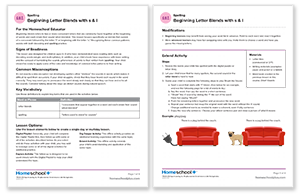COURSE
Spelling
Spelling gives your child practice with these concepts and much more:
- Decoding
- Phonemic Awareness
- Consonants
- Letter Blends
- Vowel Sounds
- Syllables
- Plurals
COURSE OVERVIEW
Learning “spells success” as you and your child explore the magic of language by identifying its standard rules and written patterns. Through hands-on letter tile practice, books, puzzles, learning videos, and more, your child will work on mastering essential spelling skills, enhancing their literacy and communication skills. They’ll also foster their writing identity and set goals for learning more, all while nurturing a love for language.
After completing this course’s 15 lessons, your child will have learned and practiced basic spelling rules and patterns of written language.
LESSON 1: Short Vowels
Tune in to the sound of language as you teach your child that vowels (a, e, i, o, u) can stand for at least two distinct sounds. They’ll learn that a long vowel sound is pronounced the same as the name of the letter it represents and that a short vowel sound is pronounced differently.
LESSON 2: BEGINNING LETTER BLENDS WITH r
Get ready to get r-r-r-rolling with learning about blends that consist of a consonant followed by the letter r. Your child will discover that consonants are non-vowel letters and that letter blends are when two or more consonant letters appear together in a word and keep their sounds when said together.
Lesson 3: Beginning Letter Blends with I and s
What begins with I and s? Loving spelling! In this lesson, your child will discover blends that are made up of a consonant followed by the letter I or beginning with the letter s, providing great practice with decoding. They’ll also learn that spelling is using letters to stand for sounds.
Lesson 4: Ending Letter Blends
Introduce your child to ending consonant blends, which are two or more consonant letters that can be found together at the end of words and maintain their own sounds when blended. Your child will also get active as they do “spelling jumping jacks,” further building their spelling and decoding skills—and a little muscle too!
Lesson 5: Three-Letter Blends
Say “yes” to the s in this lesson, as you teach your child about three-letter consonant blends that begin with the letter s, including shr-, spl-, scr-, spr-, and str–. Recognizing this common pattern assists your child with decoding and spelling practice, helping their knowledge spread!
Lesson 6: Long Vowels
Snake, rose, smile, sleep, mule: What do these words have in common? In this lesson, your child will take a deep dive into exploring long vowels and the sounds they make. By comparing long vowel sounds to short vowel sounds in words, and observing the differences, they’ll further deepen their spelling knowledge—yay!
Lesson 7: Long Vowels: Silent e
Shhh, do you hear that? Help your child discover that in certain circumstances, an e at the end of a word doesn’t stand for a sound and is silent instead. In this lesson, they’ll explore one-syllable words that end in silent e and learn that a silent e often results in the vowel sound standing for its name.
Lesson 8: Long Vowels: Vowel Teams for a & e
You and your child will make a wonderful learning duo as you explore vowel teams in this engaging lesson! Your child will learn that certain combinations of vowels can stand for the long a and long e sounds, and they’ll discover that a vowel team is two letters that combined stand for a single vowel sound.
LESSON 9: LONG VOWELS: VOWEL TEAMS FOR i, o & u
In this lesson, your child will further learn that the same spelling can represent multiple vowel sounds, and that certain vowel sounds are spelled differently in various words. They’ll also discover that specific combinations of letters can represent the long i, o, and u sounds.
Lesson 10: R-Controlled Vowels
This lesson helps your child review the concept that certain letter teams represent a single sound, like the r-controlled vowel combinations: –or, –er, and –ar. Your child will also discover that an r-controlled vowel consists of a vowel followed by the letter r, creating a distinct sound that’s different from the vowel alone.
Lesson 11: Digraphs
Two letters, one sound! In this lesson, your child will be introduced to digraphs and how they consist of two letters standing together to make a single sound. Through reviewing words like ship, wish, witch, chip, both, and thick, they’ll enhance their understanding of these letter combinations and further develop early literacy skills.
Lesson 12: Plurals
See plurals in action with your child as you explore transforming words from singular to plural form. Your child will discover that plurals are used to signal more than one of something and learn that plural words have either an –s or –es at the end, depending on their spelling.
Lesson 13: Silent Letters
Silent but significant: It’s time to learn about silent letters! In this lesson, your child will discover these letters whose sounds are not heard in the pronunciation of words. They’ll also explore common silent letters that appear at the beginning (knight, gnome), in the middle (castle, walk), or at the end of words (lamb, thumb).
Lesson 14: Homophones
Sounds like? Get ready to teach your child about homophones, words that sound alike but have different spellings and meanings. From wear/where, won/one, ate/eight, grate/great, to rose/rows, your child will have fun exploring and getting creative while using these words!
Lesson 15: The Letter y & Review
Sunny, funny, yummy—your child is the best! Congratulate them for a job well done as they review what they’ve learned in this course. They might enjoy sharing their new spelling skills with the whole family! You’ll also teach them that the letter y can stand for many different sounds, depending upon its placement in a word.
